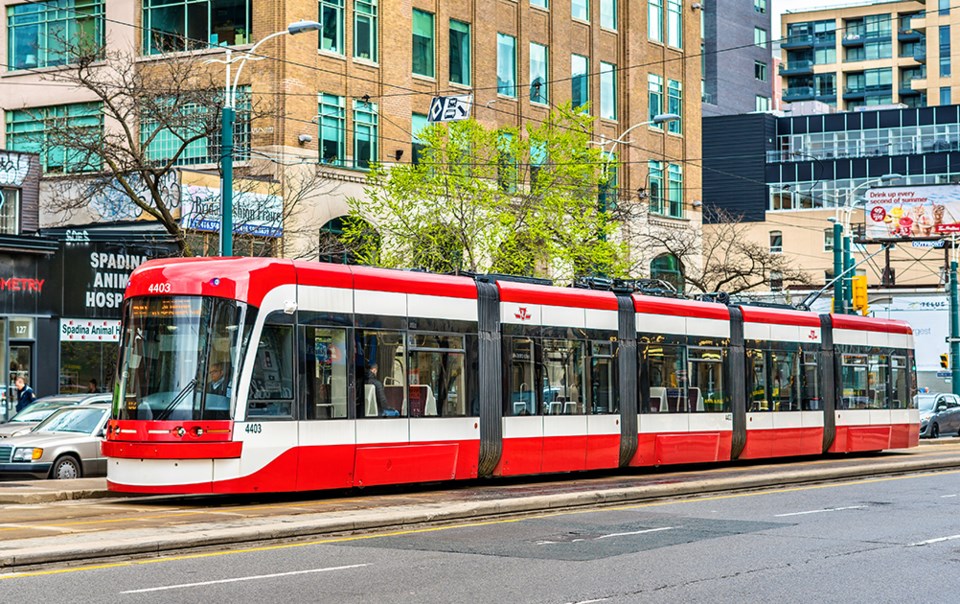Median signage proclaiming “Let’s Build a Streetcar While Libby Garvey Isn’t Looking” has begun sprouting in some parts of the Columbia Pike corridor.
Is it just someone being clever, or – nearly 10 years after the final nail was hammered into the proposal to run a 5-mile streetcar line through the corridor – is the idea primed for a comeback? Especially since Garvey, long the face of opposition to the $350 million (in 2014 dollars) proposal, in December will leave the County Board after 12 years.
The elected leader singled out on the signage doesn’t think its appearance presages a serious effort to bring back the concept.
“I’ve not seen any such signs myself and would assume that they are meant as a joke,” Garvey (currently County Board chair) told the GazetteLeader.
But, she noted, time has not dimmed her view of the project’s merits, or lack of same. And she thinks the public is with her.
“I do not think any significant number of people think a streetcar on Columbia Pike is a good idea anymore. It never was,” she said. “And the vast majority of Arlington voters agreed – which is why it was not built. And will not be.”
Many living today in Arlington were not in the county when the battle-royal went down. A primer as to what happened in the streetcar battle:
• Starting at the early part of the 21st century, proponents seeking to develop the Columbia Pike corridor along slightly more urban lines proposed a streetcar system running from Pentagon City in the east to Baileys Crossroads in the west. But in what turned out to be an ultimately fatal decision, the proposal – which at that point probably was achievable – not only got caught up in planning limbo, but began to balloon in scope (and cost) along the way.
• Garvey, who ascended from School Board to County Board in 2012 after County Board member Barbara Favola was elected to the state Senate, for two years waged what many streetcar boosters derided as a quixotic battle against the proposal.
• But as cost estimates grew, and as many in the public began to see some on the County Board as out of touch and dismissive, community opposition began to percolate.
• In the spring of 2014, after County Board member Chris Zimmerman (a key streetcar proponent) left office to take an outside job, Garvey gained an ally when independent John Vihstadt defeated Democrat Alan Howze in the special election to fill out the remainder of Zimmerman’s term.
• Streetcar proponents anticipated the arrival of streetcar skeptic Vihstadt as representing a mere blip – he and Garvey represented a minority on the five-member body, and the assumption was Vihstadt would be gone following the November 2014 general election, when he had to defend the seat.
• In a rarity for Democratic-dominated Arlington, Vihstadt defeated Howze a second time in November 2014.
• Just a week later, County Board members Mary Hynes and Jay Fisette switched sides on the issue. That change effectively killed the proposal. (Hynes and Walter Tejada, who had been left as the only streetcar supporter on the County Board, departed office in 2015; Fisette left in 2017.)
• Running for re-election, again as an independent, Vihstadt in 2018 lost to Democrat Matt de Ferranti. By that time, the streetcar battle was no longer a key issue and the race was fought on other matters.
Do those combatants of 2014 and 2018 see a revitalized push for a streetcar to be viable?
“I do not believe a streetcar along Columbia Pike will be reconsidered,” de Ferranti told the GazetteLeader.
“The county has moved on and is investing in other transportation improvements along the Pike,” he said. “We must complete that work and not relitigate the streetcar.”
Vihstadt was of like mind. “Of course, bad ideas have a way of reviving and history sometimes repeats itself, but I don’t think Arlingtonians would stand for a resurrection,” he told the GazetteLeader.
“A decade has shown that the Pike is developing and traffic is moving without the streetcar and the gentrification it would have brought,” he said. “Meanwhile, the D.C. streetcar along H Street, N.E., remains free because not many would ride it otherwise.”
After the streetcar proposal petered out, there was a momentary move to consider a gondola network rising above Columbia Pike. But it didn’t gain traction.
And, as de Ferranti noted, the Columbia Pike corridor has endured two years of still-ongoing construction work to improve traffic flow throughout the corridor – ladling another two years of disruption to construct a streetcar system might send some residents over the edge.



